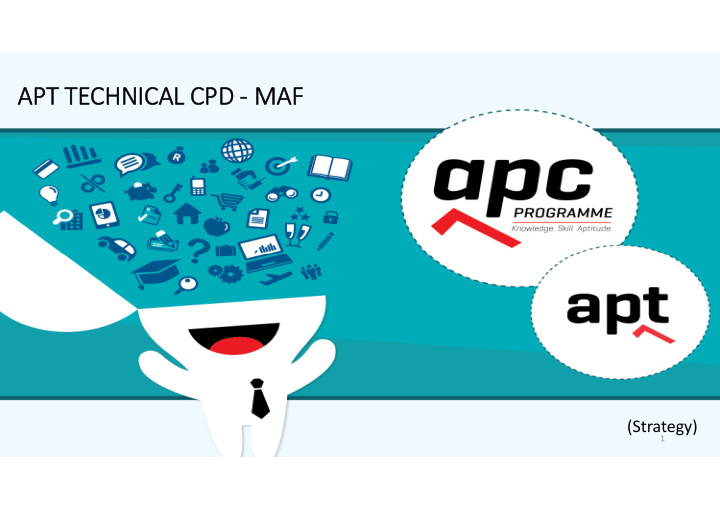



APT TECHNICAL CPD - MAF (Strategy) 1
Strategy and Risk management Nicholas Riemer Nicholas.Riemer@firstrand.co.za
Agenda • Workflow related to strategy • Strategy recap? Generic Problem • Strategy in the real world, industries? • What is the specific problem in the case study? • How to incorporate into your file
Strategy and Risk Workflow Approach
What is Strategy, generic problem? • Where are we now? • Assessment of current position of the entity and its environment • Performance, resources, capabilities, strengths, weaknesses, economic conditions • Where do we want to go? • Entity’s vision/Objectives • How are we going to get there? • Strategy – Entities Plan of Action to achieve the Objectives = Sustainable competitive advantage!!
What is Risk Management generic problem? • Company sets objectives (Where do we want to go?/Business/Financial • IDENTIFICATION of Risk of not achieving strategic objectives • ASSESSMENT of Risk • Likelihood of occurrence • Severity of risk • RESPOND to risks identified and assessed • Avoidance, transference, mitigation, acceptance
Strategy • When to use a structured approach? • How to identify “Triggers” in the scenario? • How to develop a “Plan of Action”? -Generic points(Industry Competitors, stakeholders, current strategy etc) -Models -Case study specific -Conclusion NB
STRUCTURED APPROACH • Porters 5 forces • PESTEL • SWOT IF SPECIFICALLY STATED USE A PORTERS/PESTEL/SWOT IN THE CASE STUDY!!! USE THE RELEVANT STRUCTURES TO HELP YOU IN ANSWERING WHAT THEY ASKED! Helps to get your mind thinking: • External Environment – PESTEL and PORTERS TRIGGERS ! • Internal Environment – SWOT (Strengths and Weaknesses)
Problems with ALWAYS using a structured approach? Different Structures overlap each other e.g Threats in SWOT vs PESTEL Does using a particular structure necessarily cover all of the strategic implications applicable to the scenario? Does a scenario fit exactly into a structure? (e.g. Porters) NB!
NB Models for APT and APC. • Mendelow’s matrix cont.: Interest Low High Low Minimal Keep effort informed Power High Keep Key players satisfied 10
External environment for APT NB swOT, Pestel, Porters General economic conditions; laws and regulations; population demographics; societal values and lifestyles; technology Immediate industry and competitive environment i.e. suppliers, buyers, substitutes, new entrants, rivals Company • Identify positives and negatives i.e. opportunities and threats • All relevant factors need to be considered and monitored • Industry and competitive environment generally have biggest impact on shaping strategy 11
PESTEL analysis • Framework used to analyse macro-environmental factors and identify opportunities and risks • Fundamental factors – changes can lead to changes in industry P = Political • Influence of government and current political environment e.g. taxes, policies, trade restrictions, laws and regulations, political stability etc. E = Economic • E.g. Economic growth, interest rates, exchange rates, inflation etc. S = Social • E.g. culture, accepted norms, demographics, changes in society e.g. ageing population T = Technological • Impact on entity of technology and advances in key areas e.g. research and development activity, automation, pace of technological change 12
PESTEL analysis cont. E = Environmental • Impact of natural environment on entity and vice-versa e.g. weather, climate change, pollution L = Legal • Laws, regulations and changes thereof • Inter-relation between factors very important • Regular review as a whole 13
Porter’s Five Forces • Used to assess strength of industry’s competitive forces • Five forces affecting industry attractiveness: 1. Bargaining power of buyers 2. Bargaining power of suppliers 3. Threat of substitute products 4. Threat of new entrants 5. Rivalry among existing sellers to attract buyers 14
SWOT analysis • Taking stock of company’s internal S trengths and W eaknesses as well as external O pportunities and T hreats • Provides overview of company’s overall situation • Simple yet powerful tool – provides basis for crafting strategy that exploits company’s strengths, aims at capturing best available opportunities and defends against threats • Difference between: • Strength vs opportunity • Weakness vs threat • Resource strengths and core competencies: • E.g. strong financial position and resources to grow business; strong brand name or reputation; economy of scale; learning curve advantage; important patents; great customer service etc. 15
Evaluating company’s internal situation SWot • Completes understanding of “where are we now” • Five main areas: 1. How well company’s strategy is working 2. Company’s competitively important resources and capabilities 3. Competitiveness of company’s prices and costs 4. Competitive strength / weakness of company relative to rivals 5. Priority strategic issues and problems 16
Other Strategic Analysis Tools • Osterwalder/ Nine Building Blocks of a business model • Ansoff Product-Market Matrix • BCG growth-share matrix • GEC Model • Mendelows Matrix • Nice to use when analysing companies, can point you in the right direction.
FINANCIAL RISKS and MITIGATION techniques • Types of Financial Risks • Interest Rate Risk • Exchange Rate Risk • Commodity Price Risk • Liquidity Risk • Refinancing Risk • Credit Risk • Etc. • Identify which of the above risks are applicable to the scenario
Specific Industry • EXTERNAL!!!!!!!!!!!!!! • What is the industry • Listed competitors Integrated reports • Interim financial statements • SENS • Models; Porters, OT, PESTEL • General google search on what’s happening in the industry • Strategy can always be triggered • Qualitative aspects of investments.
Case Study • Majority INTERNAL!!!!!!!!!! • Will be looking at what the current strategy is • Is this working • Who are the stakeholders • Where do they want to go • What is the company doing to get there • Then you will go and look at the external factors not given in the case study. • CTA/ITC External given. APT not given must research
File • 1) Summary of models • 2) Summary of Internal factors • 3) Summary of External factors • 4) Coverage, numbered triggers for strategy trigger if there • 5) Rest of your notes below if needed. • Good way to have all the points on hand for the day. And if not triggered can look to incorporate into the finance tasks.
Recommend
More recommend